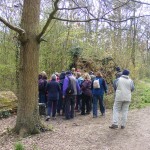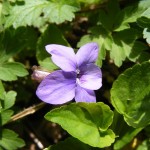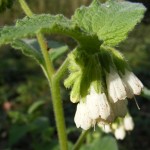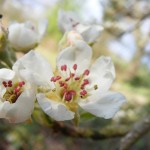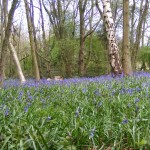There was a strong northerly breeze blowing on the afternoon of Sunday, April 15, bringing with it a few short showers of rain and hail. Nevertheless, 23 members assembled by Clayfield Copse, next to Caversham Park, to look at spring flowers, led by Michael Keith-Lucas. No-one could have been disappointed – most of the spring flowers that could have been expected were there and in flower, giving proof, if any were needed, that it is not always necessary to travel far to visit good sites. To be able to learn from the knowledge and experience of our leader was an added bonus. We learned how to distinguish the two common violets, the Common Dog Violet Viola riviniana, and the Wood Dog Violet Viola reichenbachiana, the polyploid and diploid forms of Lesser Celandine Ranunculus ficaria, the male and female Dog’s Mercury Mercurialis perennis, male and female Yew trees Taxus baccata, and why Sorbus torminalis is called in English the Wild Service Tree. Differences between the floras of Blackhouse Wood, which is ancient woodland, and Clayfield Copse, part of which was old park land which had been neglected and become woodland, were noticed. The old park land still had some Lebanon Cedars Cedrus libani to emphasise the point. Besides the Wild Service Tree, two other unusual members of the Rosaceae were noticed – the Wild Pear Pyrus pyraster, and the Wild Apple Malus sylvestris subsp. sylvestris. The Goldilocks Buttercup Ranunculus auricomus and an unusual Comfrey which when keyed out proved to be the White Comfrey Symphytum orientale added to our lists. Green Woodpeckers Picus viridis were seen and heard throughout the afternoon, and at one stage there were several voles, scuttling among the fallen wood and leaf litter.
Report by David Cliffe
Pictures by Rob Stallard
Species List – flowering plants
Taxus baccata Yew
Cedrus libani Lebanon Cedar
Anemone nemorosa Wood Anemone
Ranunculus auricomus Goldilocks Buttercup
Ranunculus ficaria Lesser Celandine
Viola reichenbachiana Wood Dog Violet
Viola riviniana Common Dog Violet
Alliaria petiolata Garlic Mustard
Cardamine pratensis Cuckoo Flower
Lunaria annua Honesty
Primula veris Cowslip
Primula vulgaris Primrose
Malus sylvestris subsp. sylvestris Wild Apple
Prunus avium Wild Cherry
Pyrus pyraster Wild Pear
Prunis spinosa Blackthorn
Sorbus aucuparia Rowan
Sorbus torminalis Wild Service Tree
Ribes rubrum Redcurrant
Euphorbia amygdaloides Wood Spurge
Mercurialis perennis Dog’s Mercury
Geranium robertianum Herb Robert
Sanicula europaea Sanicle (leaves only)
Symphytum orientale White Comfrey
Stachys sylvatica Hedge Woundwort (leaves only)
Glechoma hederacea Ground Ivy
Veronica hederifolia Ivy-leaved Speedwell
Veronica montana Wood Speedwell
Scrophularia nodosa Common Figwort (leaves only)
Lonicera periclymenum Honeysuckle (leaves only)
Hyacinthoides non-scriptus Bluebell
Ruscus aculeatus Butcher’s Broom
Arum maculatum Lords-and-Ladies
Corylus avellana Hazel (in leaf)
Betula pendula Silver Birch
Carpinus betulus Hornbeam
Cornus sanguinea Dogwood
Daphne laureola Spurge Laurel (in fruit)
Melica nutans Wood Melick
Carex pendula Pendulous Sedge
Carex sylvatica Wood Sedge
Species List – fungi
Daldinia concentrica King Alfred’s Cakes
List by David Cliffe

